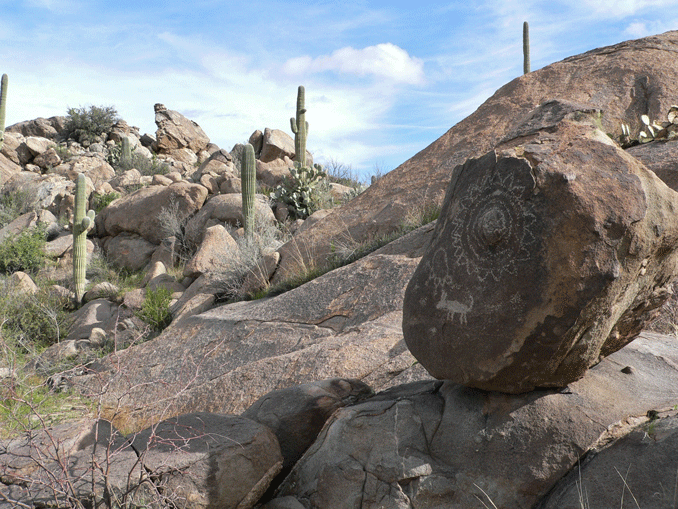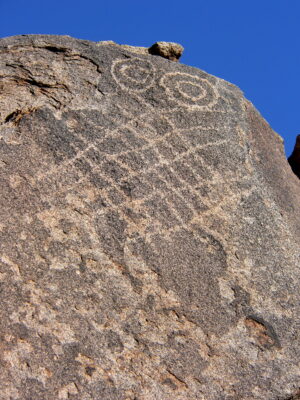- Tag

A place of special significance to the late Preclassic Hokokam is located at the base of the western slope of the Santa Catalina Mountains near Tucson. Taken in context with other anthropological information, it appears that Sutherland Wash Rock Art District was a ceremonial place with emphasis on the Uto-Aztecan Flower World. Flowers hold special meaning to speakers of Uto-Aztecan languages representing a spiritual landscape, a flowery, colorful, glittering paradise, that can be evoked through prayers, songs and other human actions. Previously reported in kiva murals and ceramics, Jane H. Hill suggested that such imagery might also be found in rock art.
A rich set of data recently created by a team of volunteers from AAHS and the Arizona Site Stewards includes a detailed recording of 3,251 prehistoric petroglyphs, a variety of surface features, artifacts, trails, solar markers and the results of a rudimentary acoustic experiment. In these data we found three important lines of evidence suggesting the special significance of Sutherland Wash. The first is the Flower World complex which is evident not only in petroglyphs representing both realistic and abstract flowers but also in glyphs depicting important related imagery including birds and butterflies. Second, the importance of gender is apparent in many male and female anthropomorphs, vulva forms, family groups, birthing scenes, and a landscape that includes yoni and phallus formations. Third, the interaction of sunlight and shadows with some of the panels clearly marked the equinoxes and solstices; one panel is a compelling horizon marker at the summer solstice involving Romo Peak where copper bells of Mesoamerican origin were found in the 1940s.

Utilized for centuries by many cultures, the National Register Sears Point Archaeological District (SPAD) is located along the rich riparian habitat of the Gila River. Currently managed by the Yuma District of the Bureau of Land Management, a large portion of the District is designated an Area of Critical Environmental Concern and is still utilized by several of the 15 Tribes that claim cultural affiliation there.
Responding to a BLM request for comprehensive rock art recording, Rupestrian CyberServices and Plateau Mountain Desert Research not only mapped approximately 2000 petroglyph panels and 100 features including rock piles, rock rings, artifact scatters, a rock shelter, several apparent natural and constructed hunting blinds, geoglyphs, and scattered rock alignments; but also, many historic features and an extensive network of pre-historic, historic, and animal trails. Recording and photographing SPAD required a three-year effort with the help of 50 volunteers, and some unusual techniques.
Tucson Balloon Rides assisted us by providing a low-elevation flight path from which we observed and photographed subtle features that were otherwise difficult to view from the ground and impossible to discern from available aerial photography.
Extensive measurements were made and recorded on multiple page forms during 16 weeks of fieldwork and subsequently entered into FileMaker Pro and Excel databases. 18,000 photographs are catalogued and identified by panel number in a Portfolio image database.
This presentation will provide not only a birds-eye view of the area, but also some intriguing petroglyph designs and preliminary analyses of the 8000 individual rock art elements.
